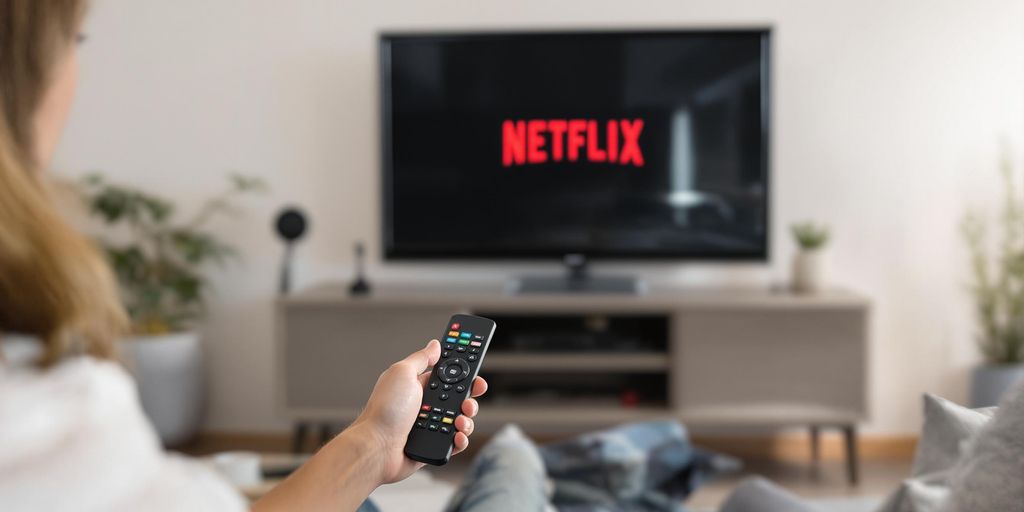Decoding the Netflix Annual Report for Aussie Investors
Key Takeaways for Australian Shareholders
Alright, so Netflix drops its annual report, and you’re thinking, "What does this mean for my investments, mate?" Well, let’s break it down. The report gives us a peek into Netflix’s overall performance, subscriber numbers, and future plans, all of which can impact its share price and, therefore, your portfolio. For Aussie investors, it’s about understanding how global trends translate to our local market. Are they gaining or losing subscribers here? Is their content strategy working with Aussie viewers? These are the questions we need to answer.
Understanding the Global Streaming Landscape
Netflix doesn’t operate in a vacuum. They’re up against everyone from Disney+ to Stan, and even free-to-air TV trying to get into the streaming game. The annual report helps paint a picture of Netflix’s financial statements in this global battle. It shows where Netflix is strong, where they’re weak, and how they plan to stay ahead. Think of it like this: if Netflix is spending big on content in Asia, that might mean less investment in Aussie productions, which could affect subscriber growth here. It’s all connected.
What the Numbers Mean for Your Portfolio
Okay, let’s get down to brass tacks. The numbers in the annual report aren’t just random figures; they’re clues. Revenue growth, profit margins, and debt levels all tell a story about Netflix’s financial health. If revenue is up but profits are down, that could mean they’re spending too much on content or marketing. If debt is rising, that could make them vulnerable if the streaming market slows down. As an investor, you need to translate these numbers into a simple question: Is Netflix a good investment right now? The annual report is a key piece of the puzzle, helping you decide whether to buy, hold, or sell.
Netflix’s Financial Health: An Australian Perspective
Revenue Streams and Subscriber Growth Down Under
Okay, so how’s Netflix actually doing in Australia? It’s not just about how many people are watching Heartbreak High (though that probably helps!). We need to look at where their money’s coming from. Obviously, subscriptions are the big one, but are they growing? Are they holding steady? Or are Aussies ditching Netflix for other streaming options? Subscriber growth is key, and we need to see if it’s keeping pace with the overall growth of the video streaming industry. A decline in subscriber growth could signal trouble.
Profitability and Cash Flow Analysis
Revenue is one thing, but profit is another. Is Netflix actually making money in Australia, or is it just spending a heap to get us hooked? We need to dig into their profitability. What are their costs like – content production, marketing, infrastructure? And how does that compare to the revenue they’re pulling in from Aussie subscribers? Cash flow is also important. Do they have enough cash on hand to keep investing in new content and growing their business? A healthy cash flow is a good sign, while a negative one might raise some eyebrows. It’s like that time I tried to start a veggie garden – spent all this money on seedlings and fancy soil, but ended up with, like, two tomatoes. Not exactly profitable, was it?
Debt and Equity: A Look at the Balance Sheet
Let’s have a squiz at Netflix’s balance sheet. How much debt are they carrying? Are they relying heavily on borrowing to fund their operations, or are they mostly funded by equity (i.e., selling shares)? Too much debt can be risky, especially if interest rates start to climb. On the other hand, a healthy mix of debt and equity can be a sign of a well-managed company. It’s all about finding the right balance. Think of it like balancing your budget – you don’t want to be drowning in credit card debt, but a small mortgage can be manageable. Here’s a quick rundown of what to look for:
- Total Assets: What Netflix owns (content, equipment, etc.)
- Total Liabilities: What Netflix owes (debt, accounts payable)
- Equity: The value of the company owned by shareholders
Market Performance and Shareholder Value
ASX vs. NASDAQ: Netflix’s Stock Trajectory
Okay, so let’s have a yarn about how Netflix shares are doing, both here and in the US. We need to look at the ASX (even though Netflix isn’t directly listed here) to gauge Aussie investor interest via funds and international brokers, and then compare that to its NASDAQ performance. Are we seeing similar trends? Are Aussie investors more or less bullish? It’s worth digging into the numbers to see if there’s a divergence and, if so, why. Understanding these differences can inform your investment strategy.
Dividend Policy and Share Buybacks
Netflix doesn’t currently pay dividends, which is pretty standard for growth companies. Instead, they’ve been focusing on share buybacks. Here’s the lowdown:
- No Dividends: Don’t expect a regular income stream from Netflix shares anytime soon.
- Share Buybacks: Netflix has been repurchasing its own shares, which can boost the share price by reducing the number of shares outstanding.
- Impact on Investors: Share buybacks can be a tax-efficient way to return value to shareholders, but it’s not the same as cold, hard cash in your pocket.
Analyst Ratings and Investor Sentiment
What are the experts saying? Analyst ratings can give you a sense of the overall market sentiment towards Netflix. Are they mostly buys, holds, or sells? And what’s the general vibe among Aussie investors? Are they excited about Netflix’s future, or are they worried about competition and content costs? Keeping an eye on these indicators can help you make a more informed decision. It’s not the be-all and end-all, but it’s another piece of the puzzle. Remember, it’s all about doing your own research and not just blindly following the crowd.
Content Strategy and Local Impact
Investment in Australian Productions
Netflix’s strategy in Australia isn’t just about showing overseas stuff; they’re putting real money into local productions. This is a big deal for the Aussie film and TV industry. It means more jobs for actors, writers, and crew, and it also gives us content that actually reflects our culture and stories. Netflix’s investment helps boost the local industry and gives them a competitive edge.
Subscriber Engagement and Retention in Oz
Keeping Aussie subscribers happy is key for Netflix. They do this by:
- Offering a mix of global hits and local content.
- Personalising recommendations based on viewing habits.
- Constantly adding new shows and movies to keep things fresh.
Subscriber engagement is tracked through viewing hours, completion rates, and how often people log in. High engagement usually means people are less likely to cancel their subscriptions. Netflix needs to keep Aussie subscribers hooked to stay on top.
The Role of Original Content in Growth
Original content is a major driver for Netflix’s growth, both globally and here in Australia. Think about shows like Heartbreak High or Boy Swallows Universe – these are shows that you can’t find anywhere else, and they draw in viewers. Plus, original content helps Netflix stand out from other streaming services. It’s a way to build a brand and create a loyal fan base. The more unique and engaging content they produce, the better their chances of attracting and keeping subscribers.
Competitive Landscape in the Australian Market
Battling Local and International Streamers
The streaming landscape in Australia is a proper battleground. You’ve got Netflix, the global giant, going head-to-head with local players like Stan and Foxtel’s Binge. Then there are the other international contenders like Amazon Prime Video, Disney+, and Paramount+. It’s a crowded market, and everyone’s fighting for a slice of the Aussie pie. The competition is fierce, with each platform trying to outdo the others with content, pricing, and features.
Pricing Strategies and Market Share
Pricing is a key weapon in this streaming war. Netflix has different tiers, and the others are constantly adjusting their prices to stay competitive. Market share is always shifting as people jump between services, chasing the latest must-watch shows. It’s a game of value for money, and Aussies are pretty savvy when it comes to getting the best deal. The Australian streaming market is highly price-sensitive.
Future Challenges and Opportunities
Looking ahead, there are plenty of challenges and opportunities. One big challenge is content costs – everyone’s spending big on original shows to attract and keep subscribers. Another is dealing with churn, when people cancel their subscriptions. But there are also opportunities to grow by targeting niche audiences, partnering with telcos, and expanding into new areas like gaming. The future of streaming in Australia is going to be interesting, that’s for sure. The ASX small ordinaries index might be a good place to look for investment opportunities.
Technological Advancements and Innovation
The Impact of AI on Content Delivery
Netflix is really leaning into AI, and it’s not just some buzzword for them. They’re using it to figure out what shows you might like, which is pretty standard, but also to optimise how they actually send the video to your telly. This means less buffering and a smoother picture, even if your internet’s a bit dodgy. It’s all about making sure you can binge-watch without wanting to throw your remote at the screen. They’re also using AI to help with dubbing and subtitling, which is a massive job when you’re dealing with content from all over the world.
Personalisation and User Experience
Netflix’s whole game is keeping you glued to your screen, right? So, they’re constantly tweaking the user experience. It’s not just about suggesting shows; it’s about how they present them to you. Think about the thumbnails – they’re not random. Netflix uses what they know about your viewing habits to show you the images that are most likely to grab your attention. It’s a bit sneaky, but it works. They also A/B test different layouts and features all the time to see what keeps people watching for longer. It’s a never-ending process of trying to figure out what makes us tick.
Infrastructure Investments and Scalability
Streaming video to millions of people around the world is no small feat. Netflix has to invest a truckload of money in its infrastructure to make sure everything runs smoothly. This means servers, networks, and all sorts of fancy tech stuff that most of us don’t even think about. They’re constantly working on making their system more efficient so they can handle more viewers without things grinding to a halt. Scalability is the name of the game – being able to handle a sudden surge in viewers when a new season of Stranger Things drops, for example. It’s a massive logistical challenge, but they seem to be doing a pretty good job of it so far.
Here’s a quick look at some of their tech investments:
- Content Delivery Networks (CDNs)
- Data Analytics Platforms
- AI and Machine Learning Infrastructure
Risk Factors and Future Outlook

Regulatory Hurdles and Geopolitical Risks
Let’s be real, Netflix doesn’t operate in a vacuum. They’re facing a bunch of potential headaches from different countries. Think about content regulations – what’s okay in Australia might not fly in Singapore, and that can get tricky. Also, geopolitical stuff like trade wars or political instability can mess with their expansion plans and subscriber numbers. Keeping an eye on these global events is super important for Aussie investors.
Content Costs and Production Challenges
Making shows and movies costs a fortune, and it’s only getting more expensive. Netflix is in a constant battle to create stuff people actually want to watch, and if they don’t, subscribers might bail. Plus, there are always production hiccups – delays, budget blowouts, you name it. These things can really hit their bottom line. It’s a risky game, relying on churning out hit after hit.
Forecasting Netflix’s Next Chapter
Predicting the future is impossible, but we can look at some trends. Will Netflix keep growing at the same rate? Probably not. The streaming market is getting crowded, and everyone’s fighting for a piece of the pie. Here are some things to consider:
- Subscriber growth is likely to slow down.
- Competition from Disney+, Stan, and others will keep the pressure on.
- New technologies, like AI, could shake things up.
Basically, Netflix needs to keep innovating and adapting to stay ahead. It’s not a sure thing, and investors need to be aware of the potential bumps in the road.
Environmental, Social, and Governance (ESG) Initiatives
Sustainability Efforts and Carbon Footprint
Okay, so Netflix and the environment, right? It’s not just about binge-watching with the lights off (though that helps!). They’re actually trying to cut down on their carbon footprint. It’s a bit hard to picture a streaming giant being eco-friendly, but they’re making moves.
- They’re looking at renewable energy to power their offices and data centres.
- They’re trying to make their productions more sustainable, which is a big deal when you think about all the sets, travel, and equipment involved.
- Netflix is committed to net-zero greenhouse gas emissions.
Diversity and Inclusion in Production
Diversity and inclusion are big talking points these days, and Netflix is trying to get on board. It’s not just about ticking boxes; they’re aiming to tell stories that reflect the world we live in.
- They’re working to get more people from different backgrounds in front of and behind the camera.
- There are initiatives to support emerging filmmakers from underrepresented groups.
- They’re also trying to make sure their content is accessible to everyone, with subtitles and audio descriptions.
Corporate Governance and Shareholder Rights
Corporate governance might sound boring, but it’s important for investors. It’s all about how the company is run and whether it’s being run ethically and in the best interests of shareholders.
- Netflix has a board of directors that’s supposed to keep an eye on things.
- They have policies in place to prevent corruption and conflicts of interest.
- Shareholders get a say on some important decisions, like electing directors and approving executive pay. It’s all pretty standard stuff, but it’s good to know they’re playing by the rules.
Comparing Netflix to Other Media Giants

Valuation Metrics Across the Industry
When you’re trying to figure out if Netflix is a good investment, you can’t just look at Netflix in isolation. You’ve gotta see how it stacks up against other big players in the media game. This means comparing things like price-to-earnings ratios, revenue growth, and market capitalisation. For example, you might compare Netflix to Disney, which has theme parks and merchandise, or to a pure-play streaming service like Stan. These comparisons give you a sense of whether Netflix is overvalued, undervalued, or fairly priced relative to its peers.
Growth Prospects of Streaming Peers
It’s not just about the numbers today; it’s about where these companies are headed. What are the growth strategies of streaming subscribers like Disney+, Amazon Prime Video, or even local players like Binge? Are they expanding into new markets? Are they investing heavily in original content? Are they bundling services to attract more customers? Understanding these growth prospects helps you assess whether Netflix can maintain its competitive edge or if it’s likely to lose ground to rivals. For instance, if a competitor is aggressively undercutting Netflix on price, that could impact Netflix’s future subscriber growth in Australia.
Diversification Strategies for Investors
Putting all your eggs in one basket is generally not a good idea, especially when it comes to investing. So, how does Netflix fit into a diversified portfolio? Should you also be looking at other media companies, or even companies outside the media sector altogether? Diversification can help reduce your overall risk. Maybe you balance your Netflix shares with shares in a more traditional media company, or perhaps you look at tech companies or even resource stocks. The key is to spread your investments across different sectors and asset classes. Thinking about long-term investment is important.
Actionable Insights for Australian Investors
Is Netflix a Buy, Hold, or Sell?
Okay, so you’ve read through the whole report, crunched some numbers, and now you’re probably wondering: should I chuck some dollarydoos at Netflix, hang onto what I’ve got, or bail? Well, it’s not a straightforward answer, mate. Netflix’s future performance hinges on subscriber growth, content costs, and competition from other streaming services.
- Consider your own risk tolerance. Are you comfortable with the volatility of the tech sector?
- Think about your investment timeline. Are you in it for the long haul, or looking for a quick buck?
- Keep an eye on those subscriber numbers in the Asia-Pacific region, especially here in Oz. That’s a key growth area for them.
Long-Term Investment Considerations
If you’re thinking about holding Netflix shares for the long term, there are a few things to keep in mind. The streaming landscape is constantly changing, with new players popping up all the time. Netflix needs to keep innovating and producing content that people actually want to watch, otherwise they’ll lose subscribers to the competition. Also, regulatory changes could impact their business model, especially when it comes to content restrictions and taxes. It’s a bit of a gamble, but if they play their cards right, Netflix could still be a dominant force in the entertainment industry for years to come.
Integrating Netflix into a Diversified Portfolio
Don’t put all your eggs in one basket, right? Netflix can be part of a diversified portfolio, but it shouldn’t be the only thing you’re holding. Consider balancing it out with investments in other sectors, like resources, financials, or property. That way, if Netflix has a bad year, your whole portfolio won’t take a massive hit. Think of it like a barbie – you want a good mix of snags, steaks, and maybe even some veggie skewers to keep things interesting. Diversification is key to weathering the ups and downs of the market.
Wrapping It Up
So, there you have it. We’ve had a good look at Netflix’s yearly report, trying to make sense of it for us Aussies. It’s clear they’re still a big player, but like any company, they’ve got their ups and downs. Thinking about putting your hard-earned cash into something like this means doing your homework. Keep an eye on what they’re doing next, especially with all the competition out there. It’s a wild ride in the share market, and staying informed is always a good idea.
Frequently Asked Questions
What exactly is Netflix?
Netflix is a company that streams movies and TV shows over the internet. You pay a monthly fee to watch as much as you like. They make their own shows and movies too.
How does Netflix earn its money?
Netflix makes money mostly from people paying their monthly fees. They also earn a bit from showing ads on some of their cheaper plans.
Where does Netflix spend its money?
Netflix spends a lot of cash making new shows and movies, and buying rights to other ones. They also spend on technology to make sure their streaming works well and on marketing to get more people to sign up.
Why should an Aussie investor care about Netflix’s report?
For Aussie investors, Netflix’s report helps us see how well the company is doing globally and especially in Australia. It shows if they’re getting more subscribers here and if their local shows are popular, which can affect their share price.
Can I buy Netflix shares in Australia?
Netflix shares are traded on the NASDAQ in the US. You’d need to use a broker that lets you buy US shares.
Does Netflix pay dividends?
Netflix usually puts its profits back into making more content and growing the business, rather than paying out dividends to shareholders. So, don’t expect a regular cash payout.
What are the main risks for Netflix?
Like any company, Netflix has risks. Things like more competition from other streaming services, people cancelling their subscriptions, and the high cost of making new shows can all affect them.
How important is Australia to Netflix?
Netflix is investing a lot in Australian-made shows and movies. This helps them get more Aussie subscribers and keep them happy, as people like to watch local stories.




